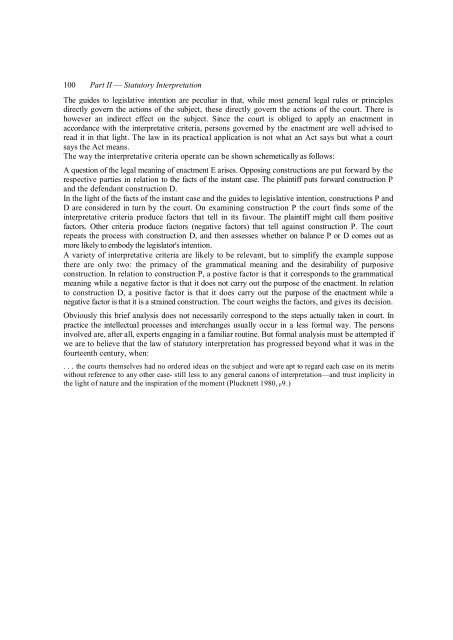Statutory Interpretation The Technique of Statutory ... - Francis Bennion
Statutory Interpretation The Technique of Statutory ... - Francis Bennion
Statutory Interpretation The Technique of Statutory ... - Francis Bennion
You also want an ePaper? Increase the reach of your titles
YUMPU automatically turns print PDFs into web optimized ePapers that Google loves.
100 Part II — <strong>Statutory</strong> <strong>Interpretation</strong><br />
<strong>The</strong> guides to legislative intention are peculiar in that, while most general legal rules or principles<br />
directly govern the actions <strong>of</strong> the subject, these directly govern the actions <strong>of</strong> the court. <strong>The</strong>re is<br />
however an indirect effect on the subject. Since the court is obliged to apply an enactment in<br />
accordance with the interpretative criteria, persons governed by the enactment are well advised to<br />
read it in that light. <strong>The</strong> law in its practical application is not what an Act says but what a court<br />
says the Act means.<br />
<strong>The</strong> way the interpretative criteria operate can be shown schemetically as follows:<br />
A question <strong>of</strong> the legal meaning <strong>of</strong> enactment E arises. Opposing constructions are put forward by the<br />
respective parties in relation to the facts <strong>of</strong> the instant case. <strong>The</strong> plaintiff puts forward construction P<br />
and the defendant construction D.<br />
In the light <strong>of</strong> the facts <strong>of</strong> the instant case and the guides to legislative intention, constructions P and<br />
D are considered in turn by the court. On examining construction P the court finds some <strong>of</strong> the<br />
interpretative criteria produce factors that tell in its favour. <strong>The</strong> plaintiff might call them positive<br />
factors. Other criteria produce factors (negative factors) that tell against construction P. <strong>The</strong> court<br />
repeats the process with construction D, and then assesses whether on balance P or D comes out as<br />
more likely to embody the legislator's intention.<br />
A variety <strong>of</strong> interpretative criteria are likely to be relevant, but to simplify the example suppose<br />
there are only two: the primacy <strong>of</strong> the grammatical meaning and the desirability <strong>of</strong> purposive<br />
construction. In relation to construction P, a postive factor is that it corresponds to the grammatical<br />
meaning while a negative factor is that it does not carry out the purpose <strong>of</strong> the enactment. In relation<br />
to construction D, a positive factor is that it does carry out the purpose <strong>of</strong> the enactment while a<br />
negative factor is that it is a strained construction. <strong>The</strong> court weighs the factors, and gives its decision.<br />
Obviously this brief analysis does not necessarily correspond to the steps actually taken in court. In<br />
practice the intellectual processes and interchanges usually occur in a less formal way. <strong>The</strong> persons<br />
involved are, after all, experts engaging in a familiar routine. But formal analysis must be attempted if<br />
we are to believe that the law <strong>of</strong> statutory interpretation has progressed beyond what it was in the<br />
fourteenth century, when:<br />
. . . the courts themselves had no ordered ideas on the subject and were apt to regard each case on its merits<br />
without reference to any other case- still less to any general canons <strong>of</strong> interpretation—and trust implicity in<br />
the light <strong>of</strong> nature and the inspiration <strong>of</strong> the moment (Plucknett 1980, P 9.)

















